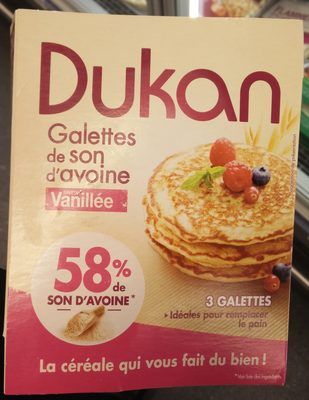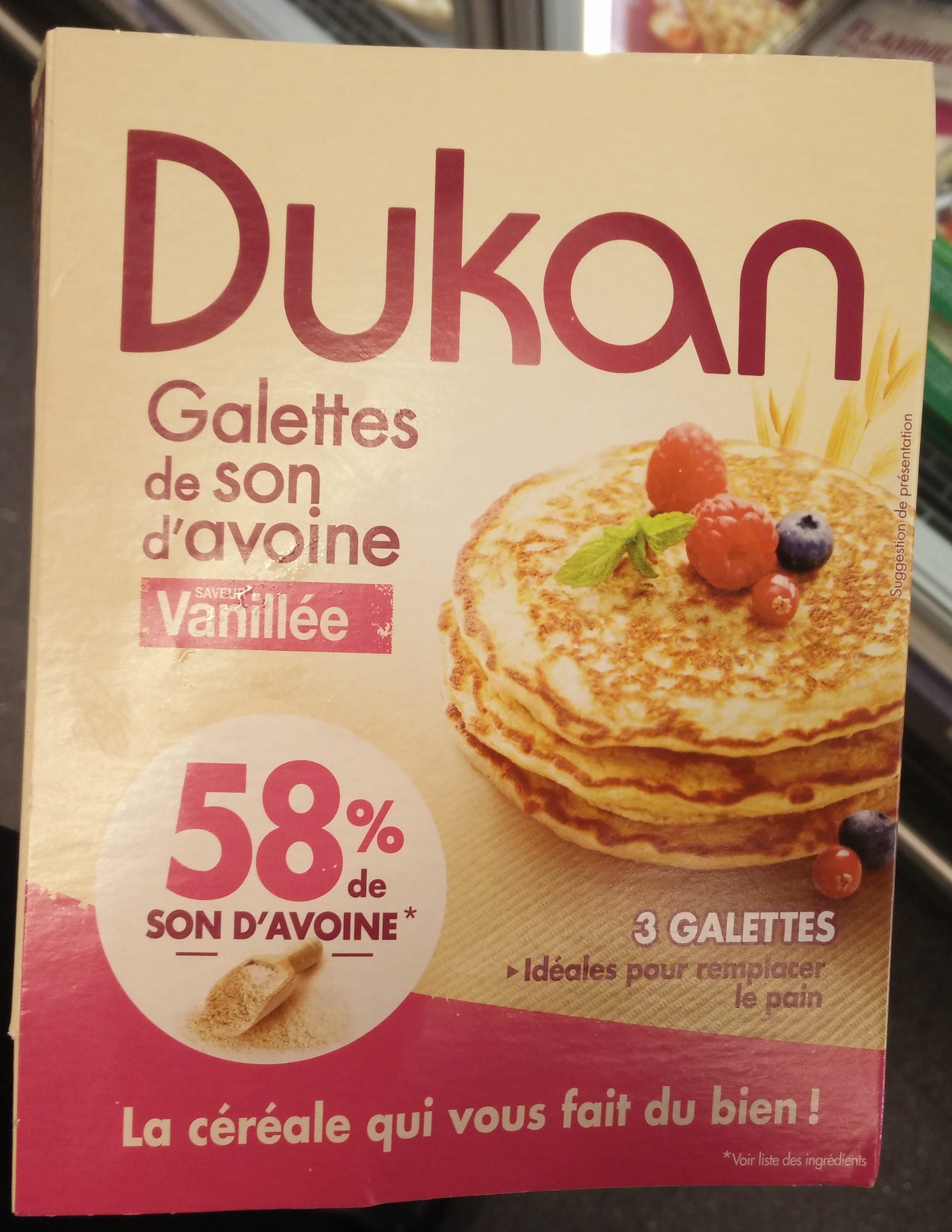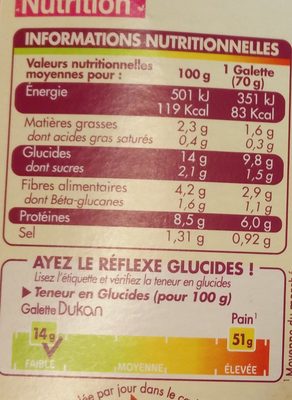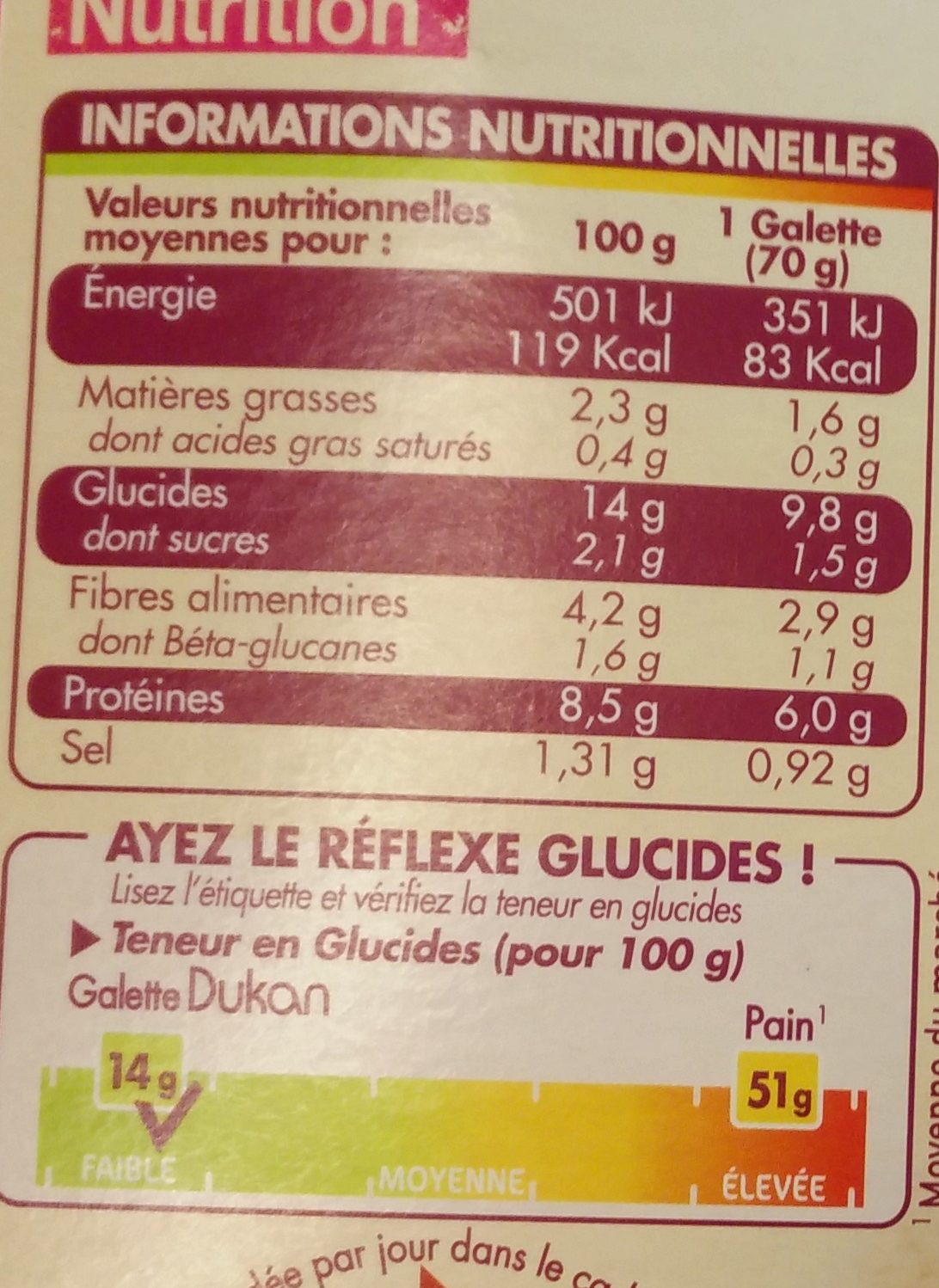Help us make food transparency the norm!
As a non-profit organization, we depend on your donations to continue informing consumers around the world about what they eat.
The food revolution starts with you!
Galettes de son d'avoine saveur vanillée - Dukan - 210 g
Galettes de son d'avoine saveur vanillée - Dukan - 210 g
This product page is not complete. You can help to complete it by editing it and adding more data from the photos we have, or by taking more photos using the app for Android or iPhone/iPad. Thank you!
×
Barcode: 3160751074884 (EAN / EAN-13)
Quantity: 210 g
Brands: Dukan
Categories: Plant-based foods and beverages, Plant-based foods, Cereals and potatoes, Cereals and their products, Puffed cereal cakes, Puffed oat cakes
Labels, certifications, awards: 2016 Nutrition labelling experiment, Nutriscore experiment, fr:Expérimentation NutriScore 0
Manufacturing or processing places: France
Traceability code: EMB 22093K - Lamballe (Côtes-d'Armor, France)
Stores: Casino
Countries where sold: France
Matching with your preferences
Health
Ingredients
-
19 ingredients
: Son d'avoine hydraté 58% [eau 37%, son d'avoine 21% (contient gluten)], eau, blanc d'œufs en poudre, lait écrémé en poudre, graines de Iin brun, conservateur (acétate de sodium, lactose), poudres à lever (diphosphate disodique, carbonate de sodium, amidon de blé), édulcorants : maltodextrine et sucralose 0,6%, arôme naturel de vanille, sel.Allergens: Eggs, Gluten, Milk
Food processing
-
Ultra processed foods
Elements that indicate the product is in the 4 - Ultra processed food and drink products group:
- Additive: E450 - Diphosphates
- Ingredient: Flavouring
- Ingredient: Lactose
- Ingredient: Maltodextrin
- Ingredient: Sweetener
Food products are classified into 4 groups according to their degree of processing:
- Unprocessed or minimally processed foods
- Processed culinary ingredients
- Processed foods
- Ultra processed foods
The determination of the group is based on the category of the product and on the ingredients it contains.
Additives
-
E262 - Sodium acetates
Sodium acetate: Sodium acetate, CH3COONa, also abbreviated NaOAc, is the sodium salt of acetic acid. This colorless deliquescent salt has a wide range of uses.Source: Wikipedia
-
E262i - Sodium acetate
Sodium acetate: Sodium acetate, CH3COONa, also abbreviated NaOAc, is the sodium salt of acetic acid. This colorless deliquescent salt has a wide range of uses.Source: Wikipedia
-
E450 - Diphosphates
Diphosphates (E450) are food additives often utilized to modify the texture of products, acting as leavening agents in baking and preventing the coagulation of canned food.
These salts can stabilize whipped cream and are also found in powdered products to maintain their flow properties. They are commonly present in baked goods, processed meats, and soft drinks.
Derived from phosphoric acid, they're part of our daily phosphate intake, which often surpasses recommended levels due to the prevalence of phosphates in processed foods and drinks.
Excessive phosphate consumption is linked to health issues, such as impaired kidney function and weakened bone health. Though diphosphates are generally regarded as safe when consumed within established acceptable daily intakes, it's imperative to monitor overall phosphate consumption to maintain optimal health.
-
E500 - Sodium carbonates
Sodium carbonates (E500) are compounds commonly used in food preparation as leavening agents, helping baked goods rise by releasing carbon dioxide when they interact with acids.
Often found in baking soda, they regulate the pH of food, preventing it from becoming too acidic or too alkaline. In the culinary world, sodium carbonates can also enhance the texture and structure of foods, such as noodles, by modifying the gluten network.
Generally recognized as safe, sodium carbonates are non-toxic when consumed in typical amounts found in food.
-
E500i - Sodium carbonate
Sodium carbonate: Sodium carbonate, Na2CO3, -also known as washing soda, soda ash and soda crystals, and in the monohydrate form as crystal carbonate- is the water-soluble sodium salt of carbonic acid. It most commonly occurs as a crystalline decahydrate, which readily effloresces to form a white powder, the monohydrate. Pure sodium carbonate is a white, odorless powder that is hygroscopic -absorbs moisture from the air-. It has a strongly alkaline taste, and forms a moderately basic solution in water. Sodium carbonate is well known domestically for its everyday use as a water softener. Historically it was extracted from the ashes of plants growing in sodium-rich soils, such as vegetation from the Middle East, kelp from Scotland and seaweed from Spain. Because the ashes of these sodium-rich plants were noticeably different from ashes of timber -used to create potash-, they became known as "soda ash". It is synthetically produced in large quantities from salt -sodium chloride- and limestone by a method known as the Solvay process. The manufacture of glass is one of the most important uses of sodium carbonate. Sodium carbonate acts as a flux for silica, lowering the melting point of the mixture to something achievable without special materials. This "soda glass" is mildly water-soluble, so some calcium carbonate is added to the melt mixture to make the glass produced insoluble. This type of glass is known as soda lime glass: "soda" for the sodium carbonate and "lime" for the calcium carbonate. Soda lime glass has been the most common form of glass for centuries. Sodium carbonate is also used as a relatively strong base in various settings. For example, it is used as a pH regulator to maintain stable alkaline conditions necessary for the action of the majority of photographic film developing agents. It acts as an alkali because when dissolved in water, it dissociates into the weak acid: carbonic acid and the strong alkali: sodium hydroxide. This gives sodium carbonate in solution the ability to attack metals such as aluminium with the release of hydrogen gas.It is a common additive in swimming pools used to raise the pH which can be lowered by chlorine tablets and other additives which contain acids. In cooking, it is sometimes used in place of sodium hydroxide for lyeing, especially with German pretzels and lye rolls. These dishes are treated with a solution of an alkaline substance to change the pH of the surface of the food and improve browning. In taxidermy, sodium carbonate added to boiling water will remove flesh from the bones of animal carcasses for trophy mounting or educational display. In chemistry, it is often used as an electrolyte. Electrolytes are usually salt-based, and sodium carbonate acts as a very good conductor in the process of electrolysis. In addition, unlike chloride ions, which form chlorine gas, carbonate ions are not corrosive to the anodes. It is also used as a primary standard for acid-base titrations because it is solid and air-stable, making it easy to weigh accurately.Source: Wikipedia
Ingredients analysis
-
Palm oil free
No ingredients containing palm oil detected
Unrecognized ingredients: fr:graines-de-iin-brunSome ingredients could not be recognized.
We need your help!
You can help us recognize more ingredients and better analyze the list of ingredients for this product and others:
- Edit this product page to correct spelling mistakes in the ingredients list, and/or to remove ingredients in other languages and sentences that are not related to the ingredients.
- Add new entries, synonyms or translations to our multilingual lists of ingredients, ingredient processing methods, and labels.
If you would like to help, join the #ingredients channel on our Slack discussion space and/or learn about ingredients analysis on our wiki. Thank you!
-
Non-vegan
Non-vegan ingredients: Powdered egg white, Skimmed milk powder, LactoseSome ingredients could not be recognized.
We need your help!
You can help us recognize more ingredients and better analyze the list of ingredients for this product and others:
- Edit this product page to correct spelling mistakes in the ingredients list, and/or to remove ingredients in other languages and sentences that are not related to the ingredients.
- Add new entries, synonyms or translations to our multilingual lists of ingredients, ingredient processing methods, and labels.
If you would like to help, join the #ingredients channel on our Slack discussion space and/or learn about ingredients analysis on our wiki. Thank you!
-
Vegetarian status unknown
Unrecognized ingredients: fr:graines-de-iin-brunSome ingredients could not be recognized.
We need your help!
You can help us recognize more ingredients and better analyze the list of ingredients for this product and others:
- Edit this product page to correct spelling mistakes in the ingredients list, and/or to remove ingredients in other languages and sentences that are not related to the ingredients.
- Add new entries, synonyms or translations to our multilingual lists of ingredients, ingredient processing methods, and labels.
If you would like to help, join the #ingredients channel on our Slack discussion space and/or learn about ingredients analysis on our wiki. Thank you!
-
Details of the analysis of the ingredients
We need your help!
Some ingredients could not be recognized.
We need your help!
You can help us recognize more ingredients and better analyze the list of ingredients for this product and others:
- Edit this product page to correct spelling mistakes in the ingredients list, and/or to remove ingredients in other languages and sentences that are not related to the ingredients.
- Add new entries, synonyms or translations to our multilingual lists of ingredients, ingredient processing methods, and labels.
If you would like to help, join the #ingredients channel on our Slack discussion space and/or learn about ingredients analysis on our wiki. Thank you!
: Son d'avoine 58% (eau 37%, son d'avoine 21%), eau, blanc d'œufs en poudre, lait écrémé en poudre, graines de Iin brun, conservateur (acétate de sodium, lactose), poudres à lever (diphosphate disodique, carbonate de sodium, amidon de blé), édulcorants (maltodextrine, sucralose 0.6%), arôme naturel de vanille, sel- Son d'avoine -> en:oat-bran - vegan: yes - vegetarian: yes - ciqual_food_code: 9640 - percent_min: 58 - percent: 58 - percent_max: 58
- eau -> en:water - vegan: yes - vegetarian: yes - ciqual_food_code: 18066 - percent_min: 37 - percent: 37 - percent_max: 37
- son d'avoine -> en:oat-bran - vegan: yes - vegetarian: yes - ciqual_food_code: 9640 - percent_min: 21 - percent: 21 - percent_max: 21
- eau -> en:water - vegan: yes - vegetarian: yes - ciqual_food_code: 18066 - percent_min: 4.66666666666667 - percent_max: 34.8
- blanc d'œufs en poudre -> en:powdered-egg-white - vegan: no - vegetarian: yes - ciqual_food_code: 22004 - percent_min: 1.2 - percent_max: 31.3333333333333
- lait écrémé en poudre -> en:skimmed-milk-powder - vegan: no - vegetarian: yes - ciqual_food_code: 19054 - percent_min: 1.2 - percent_max: 18.6666666666667
- graines de Iin brun -> fr:graines-de-iin-brun - percent_min: 1.2 - percent_max: 12.0444444444444
- conservateur -> en:preservative - percent_min: 1.2 - percent_max: 8.73333333333333
- acétate de sodium -> en:e262i - vegan: yes - vegetarian: yes - percent_min: 0.6 - percent_max: 8.73333333333333
- lactose -> en:lactose - vegan: no - vegetarian: yes - percent_min: 0 - percent_max: 4.36666666666667
- poudres à lever -> en:raising-agent - percent_min: 1.2 - percent_max: 6.74666666666667
- diphosphate disodique -> en:e450i - vegan: yes - vegetarian: yes - percent_min: 0.4 - percent_max: 6.74666666666667
- carbonate de sodium -> en:e500i - vegan: yes - vegetarian: yes - percent_min: 0 - percent_max: 3.37333333333333
- amidon de blé -> en:wheat-starch - vegan: yes - vegetarian: yes - ciqual_proxy_food_code: 9510 - percent_min: 0 - percent_max: 2.24888888888889
- édulcorants -> en:sweetener - percent_min: 1.2 - percent_max: 5.42222222222222
- maltodextrine -> en:maltodextrin - vegan: yes - vegetarian: yes - percent_min: 0.6 - percent_max: 4.82222222222222
- sucralose -> en:e955 - vegan: yes - vegetarian: yes - percent_min: 0.6 - percent: 0.6 - percent_max: 0.6
- arôme naturel de vanille -> en:natural-vanilla-flavouring - vegan: yes - vegetarian: yes - percent_min: 0 - percent_max: 4.47619047619048
- sel -> en:salt - vegan: yes - vegetarian: yes - ciqual_food_code: 11058 - percent_min: 0 - percent_max: 1.31
Nutrition
-
Very good nutritional quality
⚠ ️Warning: the amount of fruits, vegetables and nuts is not specified on the label, it was estimated from the list of ingredients: 0This product is not considered a beverage for the calculation of the Nutri-Score.
Positive points: 9
- Proteins: 5 / 5 (value: 8.5, rounded value: 8.5)
- Fiber: 4 / 5 (value: 4.2, rounded value: 4.2)
- Fruits, vegetables, nuts, and colza/walnut/olive oils: 0 / 5 (value: 0, rounded value: 0)
Negative points: 6
- Energy: 1 / 10 (value: 501, rounded value: 501)
- Sugars: 0 / 10 (value: 2.1, rounded value: 2.1)
- Saturated fat: 0 / 10 (value: 0.4, rounded value: 0.4)
- Sodium: 5 / 10 (value: 524, rounded value: 524)
The points for proteins are counted because the negative points are less than 11.
Nutritional score: (6 - 9)
Nutri-Score:
-
Nutrient levels
-
Fat in low quantity (2.3%)
What you need to know- A high consumption of fat, especially saturated fats, can raise cholesterol, which increases the risk of heart diseases.
Recommendation: Limit the consumption of fat and saturated fat- Choose products with lower fat and saturated fat content.
-
Saturated fat in low quantity (0.4%)
What you need to know- A high consumption of fat, especially saturated fats, can raise cholesterol, which increases the risk of heart diseases.
Recommendation: Limit the consumption of fat and saturated fat- Choose products with lower fat and saturated fat content.
-
Sugars in low quantity (2.1%)
What you need to know- A high consumption of sugar can cause weight gain and tooth decay. It also augments the risk of type 2 diabetes and cardio-vascular diseases.
Recommendation: Limit the consumption of sugar and sugary drinks- Sugary drinks (such as sodas, fruit beverages, and fruit juices and nectars) should be limited as much as possible (no more than 1 glass a day).
- Choose products with lower sugar content and reduce the consumption of products with added sugars.
-
Salt in moderate quantity (1.31%)
What you need to know- A high consumption of salt (or sodium) can cause raised blood pressure, which can increase the risk of heart disease and stroke.
- Many people who have high blood pressure do not know it, as there are often no symptoms.
- Most people consume too much salt (on average 9 to 12 grams per day), around twice the recommended maximum level of intake.
Recommendation: Limit the consumption of salt and salted food- Reduce the quantity of salt used when cooking, and don't salt again at the table.
- Limit the consumption of salty snacks and choose products with lower salt content.
-
-
Nutrition facts
Nutrition facts As sold
for 100 g / 100 mlAs sold
per serving (70 g)Compared to: Puffed oat cakes Energy 501 kj
(119 kcal)351 kj
(83 kcal)-58% Fat 2.3 g 1.61 g -74% Saturated fat 0.4 g 0.28 g -92% Carbohydrates 14 g 9.8 g -64% Sugars 2.1 g 1.47 g -79% Fiber 4.2 g 2.94 g -13% Proteins 8.5 g 5.95 g +11% Salt 1.31 g 0.917 g +137% Fruits‚ vegetables‚ nuts and rapeseed‚ walnut and olive oils (estimate from ingredients list analysis) 0 % 0 % Beta-glucanes 1.6 g 1.12 g
Environment
-
Eco-Score C - Moderate environmental impact
⚠ ️Select a country in order to include the full impact of transportation.The Eco-Score is an experimental score that summarizes the environmental impacts of food products.→ The Eco-Score was initially developped for France and it is being extended to other European countries. The Eco-Score formula is subject to change as it is regularly improved to make it more precise and better suited to each country.Life cycle analysis
-
Average impact of products of the same category: B (Score: 63/100)
Category: Puffed cereals textured bread
Category: Puffed cereals textured bread
- PEF environmental score: 0.40 (the lower the score, the lower the impact)
- including impact on climate change: 1.43 kg CO2 eq/kg of product
Stage Impact Agriculture
81.3 %Processing
8.0 %Packaging
6.0 %Transportation
4.5 %Distribution
0.2 %Consumption
0.0 %
Bonuses and maluses
-
Missing origins of ingredients information
Malus: -5
⚠ ️ The origins of the ingredients of this product are not indicated.
If they are indicated on the packaging, you can modify the product sheet and add them.
If you are the manufacturer of this product, you can send us the information with our free platform for producers.
-
Packaging with a medium impact
Malus: -11
Shape Material Recycling Impact Unknown Plastic High Unknown Cardboard Low ⚠ ️ The information about the packaging of this product is not sufficiently precise (exact shapes and materials of all components of the packaging).⚠ ️ For a more precise calculation of the Eco-Score, you can modify the product page and add them.
If you are the manufacturer of this product, you can send us the information with our free platform for producers.
Eco-Score for this product
-
Impact for this product: C (Score: 47/100)
Product: Galettes de son d'avoine saveur vanillée - Dukan - 210 g
Life cycle analysis score: 63
Sum of bonuses and maluses: -16
Final score: 47/100
-
Carbon footprint
-
Equal to driving 0.7 km in a petrol car
143 g CO² per 100g of product
The carbon emission figure comes from ADEME's Agribalyse database, for the category: Puffed cereals textured bread (Source: ADEME Agribalyse Database)
Stage Impact Agriculture
56.1 %Processing
10.8 %Packaging
19.7 %Transportation
13.0 %Distribution
0.3 %Consumption
0.0 %
Packaging
-
Packaging with a medium impact
-
Packaging parts
(Plastic)
(Cardboard)
-
Packaging materials
Material % Packaging weight Packaging weight per 100 g of product Paper or cardboard Plastic Total
-
Transportation
-
Origins of ingredients
Missing origins of ingredients information
⚠ ️ The origins of the ingredients of this product are not indicated.
If they are indicated on the packaging, you can modify the product sheet and add them.
If you are the manufacturer of this product, you can send us the information with our free platform for producers.Add the origins of ingredients for this product Add the origins of ingredients for this product
Report a problem
-
Incomplete or incorrect information?
Category, labels, ingredients, allergens, nutritional information, photos etc.
If the information does not match the information on the packaging, please complete or correct it. Open Food Facts is a collaborative database, and every contribution is useful for all.
Data sources
Product added on by tacinte
Last edit of product page on by roboto-app.
Product page also edited by packbot, quechoisir, tacite.










